[vc_row][vc_column][vc_raw_html]JTNDc3R5bGUlM0UlMEEuZ2Rsci1sb2dvJTIwJTdCJTBBJTIwJTIwJTIwJTIwbWF4LXdpZHRoJTNBJTIwMjc1cHglM0IlMEElN0QlMEElM0MlMkZzdHlsZSUzRQ==[/vc_raw_html][/vc_column][/vc_row]
About Peru
Peru
Peru, the richest country in the world, invites us to discover that it is not richer who has more but who experiences more unforgettable experiences. And to start living them you have to travel to Peru, a place where the diversity and authenticity of its culture, nature and gastronomy, keep the essence of life itself.
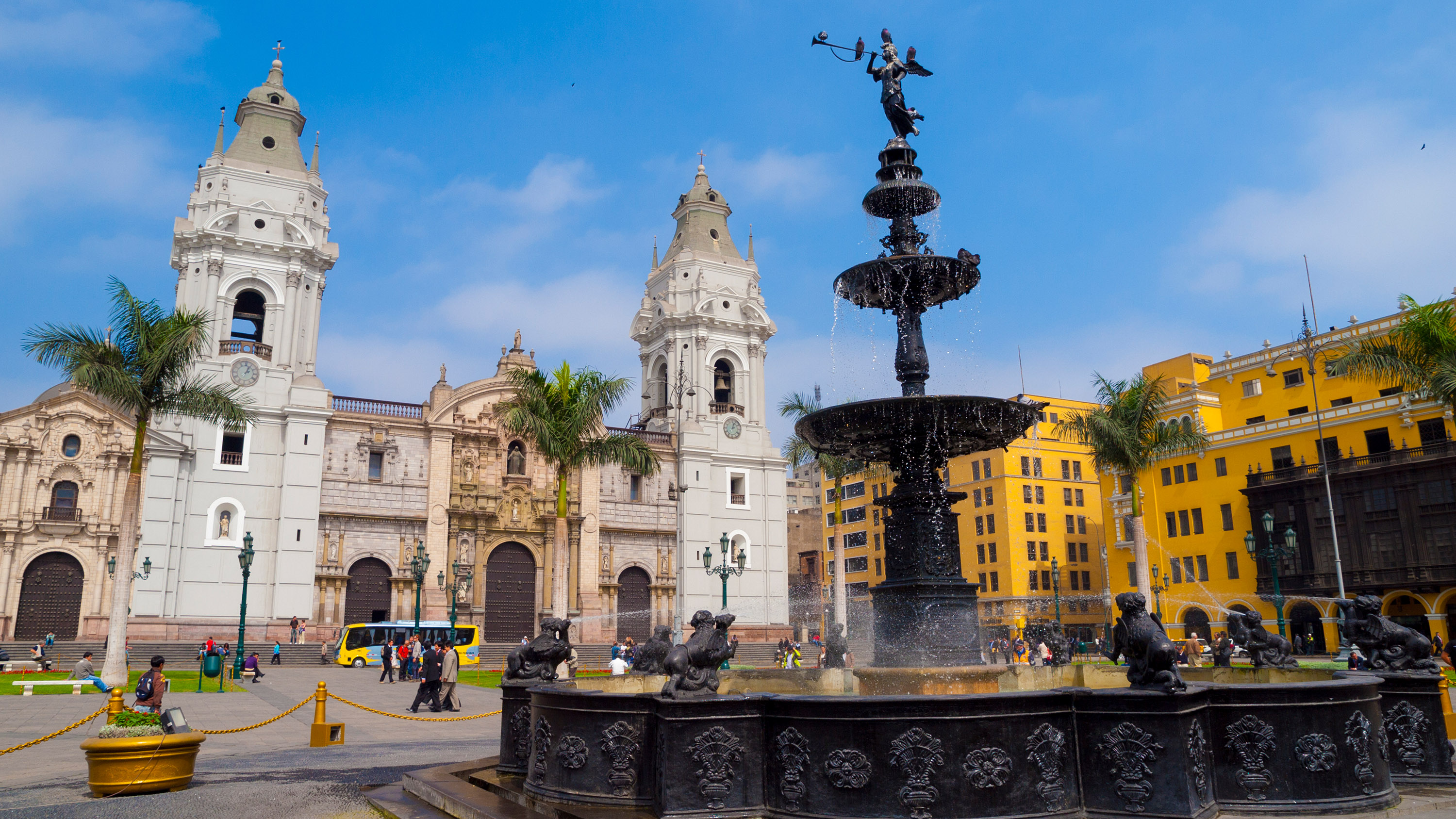
About Lima
Peru is a sum of traditions, cultures, languages. Peru is like the Amazon River, which is born from the union of several tributaries until it reaches its immensity. Peru was born this way, in the Peruvians blood flows indigenous, European, African and Eastern. This miscegenation is your strength and pride.
The pre-Hispanic cultures and the Incas managed to coexist in harmony with the rugged Peruvian geography. They dominated with wisdom a sea rich in fish and on the sands of the desert they raised pyramids that challenge time. In the Andes they made roads and bridges that are still used and built with their advanced engineering stone cities. In the jungle they adapted to nature and developed civilizations thanks to the protection of the Pachamama.
Part of these millenary cultures live today in each town and are discovered in the customs of the people. Arriving in Peru is to travel through time and rediscover the ancestral traces of the Incas, the Chancas, the Chachapoyas, the Mochicas and the Wari; as well as his great architectural works, his art, his parties, the roots of his social strength and the energy of his men.
To travel through Peru is to discover worlds with landscapes, sounds, colors and flavors of their own. Travel through time by millenarian civilizations and share with Peruvians its great cultural heritage. Search for information and enjoy countless destinations with emotions that are hard to forget. Experiences and memories that you will always carry with you.
Caral, the first civilization of America, pre-Hispanic cultures, the Inca Empire, the Inca fusion with the Hispanic world. Peru and its deserts, mountains, jungles and sea. Unforgettable landscapes. Flora, fauna and a great variety of cultural manifestations.
Peru is recognized in the world for its haute cuisine. The abundance of natural products, the fusion of techniques and cultures, forged in centuries a gastronomy with mestizo identity. The regional kitchens maintain their identity, quality and variety of flavors. Because of the excellent quality and passion of the Peruvian chefs, Lima has been named Gastronomic Capital of Latin America.
Peru, a country of adventure, history and hospitality. Peru, a world of sensations.
Culture
With more than 10,000 years of history, Peru boasts a great wealth of cultures and traditions. It has delicious, acclaimed gastronomy, possesses imposing archaeological complexes, 12 Unesco world heritage sites and has vast natural reserves. It is undoubtedly one of the most varied countries in the world.
Peru is located in the western part of South America. Its territory borders Ecuador, Colombia, Brazil, Bolivia and Chile. It covers 1,285,215 km2 of land and 200 nautical miles of the Pacific Ocean, as well as 60 million hectares in Antarctica. It has an estimated population of over 31.5 million inhabitants.
It is the third largest country in South America and one of the 20 largest in the world – its surface area covers more than the territories of Spain and France combined. Being a consultative party to the Antarctic Treaty, it has a scientific station called ‘Machu Picchu’ on this continent.
The country is divided into 25 regions or departments, including the constitutional province of El Callao, where Peru’s main port is located. The capital is Lima, a city founded in the year 1535 by the Spanish, and becoming the capital of the Viceroyalty of Peru. After independence in 1821, it became the capital of the republic.
Peru is a highly diverse country. It has 11 ecoregions and 84 of the 117 life zones that exist in the world. It has an enormous range of landscapes due to its geographical conditions, which in turn give it a great diversity of natural resources. Three main regions can be identified in its territory, which is the traditional way of dividing it according to altitudes: Coast, Mountains and Jungle.
The Jungle occupies 59% of the territory of this country, where 12% of the country’s population is concentrated. The Mountains, dominated by the Andes mountain range, occupy 30% of the territory and are home to 36% of the population. Most of the population – 52% – is concentrated on the coast, despite only occupying 11% of the national territory.
Spanish is the official language of Peru and is spoken by 84% of the population. In addition, 47 native languages are spoken in the country, including Quechua and Aymara, spoken by 13% and 1.7% of the population, respectively.
In July 2016, a new government took charge, headed by the president Pedro Pablo Kuczynski from the party Peruvians for Change. This was the fourth democratically elected government after the transitional government of 2000, which announced general elections for the following year, showing the political stability of this country.
Parties
The confluence of creeds, customs and experiences have created in the lives of Peruvians about 3,000 popular festivals a year, including patron saints, processions, carnivals and rituals, expression of faith in a God, respect for nature and the celebration of freedom. The parties in Peru have a mystical aspect, most manifest the fusion of Catholicism with the pre-Hispanic traditions of each region. The payment to the land is part of the main celebrations in all regions, under the concept of giving back to the Pachamama (Mother Earth) for her eternal generosity.
Music and Dance
Since pre-Hispanic times, music and dance have played an important role in Peruvian society. Ancient Peruvians used sea shells, reeds and even animal bones to produce sounds. It is said that the Peruvians of the Nazca culture were the most important pre-Hispanic musicians on the continent. Panpipes or zampoñas, terracotta trumpets and pututos were some of the most important musical instruments in ancient Peru. The music explored religious, war and secular themes.
Another result of its many cultures, Peru today has a rich and varied folklore and a wide diversity of both musical styles and dances, which combine indigenous genres and spirit with Hispanic influences, as well as modern styles that have adapted to the changes and tastes of society’s main social groups.
Idiosyncrasies
Peruvians are increasingly proud of their historical and cultural wealth, both past and present. After turning our backs on our Andean origins for centuries, modern Peru now fully recognises the value of the Andes and the Amazon for all that they represent in terms of resources and ancient traditions.
We are the oldest civilisation in South America. It was from Peruvian territory and our empire that neighbouring countries emerged. Peru was the political and productive centre of the region, with an excellent geographical location.
Modern Peru boasts entrepreneurs who have rediscovered their capacity to create new riches, businesses and services. The country has overcome difficult political and economic crises. Although Peru is still undergoing the consolidation of its State institutions, the country has now seen over two decades of democracy.
In general, Peru is welcoming, just like its people, who are incredibly attentive to visitors, with their food and many celebrations. Peruvians are passionate about football, and, as well as being the national sport, it is a great reason for family and friends to get together.
Peruvian people are very religious and Catholicism features prominently in their lives, but it exists peacefully alongside other belief systems.
Lima
In the north is the city of Caral, the oldest civilization of America, and to the south is the Archaeological Complex of Pachacamac. Lima’s history predates the colonial presence in the country. The establishment of the viceroyalty transformed the city into the main political and administrative center of South America.
During this period, significant churches, monasteries, mansions and balconies were built. The arrival of modernity didn’t transform the historic center, which is recognized as a World Heritage Site.
Museums with great works of art, archaeological sites, beaches, the boardwalk, valleys, natural reserves, the nightlife, the thrill of adventure sports, and the exquisite cuisine gives Peru’s capital an authentic personality and makes tourism in Lima a unique experience in the country.
Location: On the west central coast of Peru, on the shores of the Pacific Ocean.
Extension: Metropolitan Lima: 2,817 km2.

Climate
ARID AND SEMICLEID
Maximum temperature 27° C (81°F )
Minimum temperature 14° C (57°F )
Access roads
It is connected by the Pan-American Highway with several cities of the coast of Peru, Ecuador and Chile. Towards the east, the Central Highway allows communication with different cities of the sierra and the central jungle.
AERIAL ACCESS ROUTE
Regular flights to the main cities of the world from the Jorge Chávez International Airport (located in the Province of Callao, 40 minutes from the city of Lima).
Distances from the city of Lima
Lachay National Reserve 105 Km / 2 hours 30 minutes
Pachacamac 35 Km / 1 hour 10 minutes
Caral 206 Km / 4 hours
Lunahuaná 181 Km / 3 hours
Barranca 194 Km / 2 hours 30 minutes
Altitude
Minimum 3 msnm (Ancón)
Maximum 861 msnm (Chosica)
Attractions in the city
Lima Plaza Mayor (Main Square)
Visiting Hours : All day and night.
Location : Historic Centre of Lima.
Centre of the old colonial city. Around its edge are the Lima Cathedral, Government Palace and Provincial Municipal Authority of Lima. A highlight of the central part is a bronze fountain from the 17th century.
Lima Cathedral
Visiting Hours : Mon – Fri 9.00 am – 5.00 pm / Sat 10.00 am – 1.00 pm.
Location : Lima’s Plaza Mayor.
It occupies the site where the first major church in Lima once stood. It has an austere interior, although it is home to genuine historical treasures including the Baltasar Noguera choir stalls, several side altars and the remains of Francisco Pizarro. Tourists can also visit the Museum of Religious Art, which holds a significant collection of paintings, sculptures, chalices and chasubles.
Government Palace
Visiting Hours : Prior arrangement.
Location : Lima’s Plaza Mayor.
Residence of Francisco Pizarro (1535), who built it on the ground previously occupied by Taulichusco, chief of the Rímac valley. Since then, the site has been the centre of political power in Peru. The building was rebuilt in the 1920s after a fire. It has many courtyards and halls dedicated to important figures in Peruvian history which have been carefully decorated with outstanding works of art. Daily, at 11:45, the Patio de Honor (Honour Courtyard) is the setting for the changing of the guard under the responsibility of the glorious Battalion of the Hussars of Junín.


San Francisco Church and Convent
Visiting Hours : Mon – Sun 7.00 am – 11.00 am
Location : Jr. Ancash block 3.
Lima
A 17th-century archaeological complex. It includes the church, convent and plaza. The main façade of the temple was built using stone and features Corinthian columns. The façade boasts an open cornice with arches in which the Immaculate Conception is depicted. The cloisters area, decorated with tiles, houses the Museum of Vice-Royalty Art. The catacombs (subterranean galleries), which served as a cemetery during the colonial era, can also be visited.
Gastronomy House
Visiting Hours : Tuesday – Sunday 9.00 am – 5.00 pm. Free Admission.
Location : Jirón Conde de Superunda No 170.
Lima
The museum offers a tour through over 500 years of history and ancient wisdom, up to the fusion of flavours and the influence of other cultures on Peruvian cuisine. Located in the house of Lima’s old Post Office, next to the Government Palace, there are four rooms: the Permanent Hall, the Temporary Hall, the Multimedia Hall and the Pisco Hall, dedicated to our national drink. The tour also demonstrates the evolution of Peruvian cuisine, which also shows the products used in the present day.
ATTRACTIONS BEYOND THE CITY
Mamacona Estate (Lurín)
Visiting Hours : Daytime.
Location : Km 25 on the Panamericana Sur. 20 minutes from Lima.
A traditional manor house, whose owners have been involved in breeding Peruvian Paso horses for years. Twice a week they put on a show in which visitors can see the delights of these unique animals, accompanied by a dinner of regional food and a folkloric show.
Pachacámac Town (Lurín)
Visiting Hours : Daytime.
Location : 35 km south of Lima.
One of the last valleys of Lima. Visitors can take a tour through the Plaza de Armas and the Pisco Museum, followed by a walk through the Green Ravine and an eco-tourism tour through the Lúcumo Hills. Visitors can also see the Piedra del Amor (Love Stone) in the Cardal (a rock formation similar to a couple sitting down and embracing), as well as paragliding from the Punta Blanca Hill. An ideal setting for open-air sports.
Pachacámac Archaeological Complex (Lurín)
Visiting Hours : Mon – Sun 9.00 am – 4.00 pm (site’s museum).
Location : 31 km south of Lima, on the Panamericana Sur Highway (1 hour),Lima.
The most important commercial centre on the Peruvian coast since pre-Inca times. The site holds palaces, plazas and temples built with mud (some of which have been restored), among which the Temple of the Sun and the Acllahuasi are highlights. Both were built during the Inca era (1440-1533), in the best preserved sector. There is a site museum with items discovered during excavations.


Lunahuaná (Cañete)
Visiting Hours : Daytime and at night. Accommodation available.
Location : 181 km south of Lima.
This is a very fertile land where orchards and vineyards stretch along both sides of the Cañete River. Perfect for adventure sports or open-air activities, including rafting, mountain biking and hiking. It offers a varied cuisine, as well as delicious pisco and regional wines. In its surroundings, the Incahuasi archaeological site can be found, which dates back to the middle of the 15th century. The site has beautiful hanging bridges, temples and towns that can be toured on horseback.
Caral (Barranca)
Visiting Hours :Daytime.
Location : 206 km north of Lima, at km 184 on the Panamericana Norte.
The Caral Sacred City has been declared a UNESCO World Heritage Site. The site corresponds to the most ancient civilization in Peru and the Americas (5,000 years old). Together with Mesopotamia, Egypt, India, China and Mesoamerica, it is one of the cultures that allowed States, cities and great civilizations to flourish. Plazas at the foot of imposing pyramid constructions have been discovered. This is where inhabitants met to worship gods and exchange products, under the gaze of political and religious authorities.
GASTRONOMY
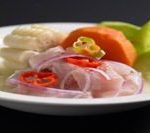
Cebiche
Fish fillet cut into pieces cooked with lemon, onion and hot Limo chilies.
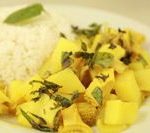
Cau-cau
Stewed mondongo (tripe) cut into small pieces with potato, ‘palillo’ and mint.

Causa rellena
Yellow potato dough seasoned with ground chilies and filled with tuna or chicken.

Escabeche (pickle)
Fish or chicken, marinated in vinegar and slow-cooked in a pot crammed full of onions.
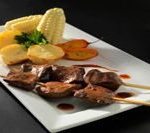
Anticuchos
Brochettes of cow hearts marinated in vinegar and ‘Panca’ chilies, roasted on the grill.
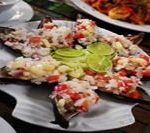
Choros a la chalaca
Mussels with onions and a pinch of chili pepper, seasoned with lemon juice.

Carapulcra
Steamed dried potatoes stewed with pork and chicken, ‘Panca’ and ‘Mirasol’ chilies, garlic and other spices.
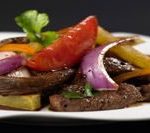
Lomo saltado (Fried loin)
Strips of beef fried with onion, tomato, chilies and various herbs. Served with chips and rice.


 Español
Español